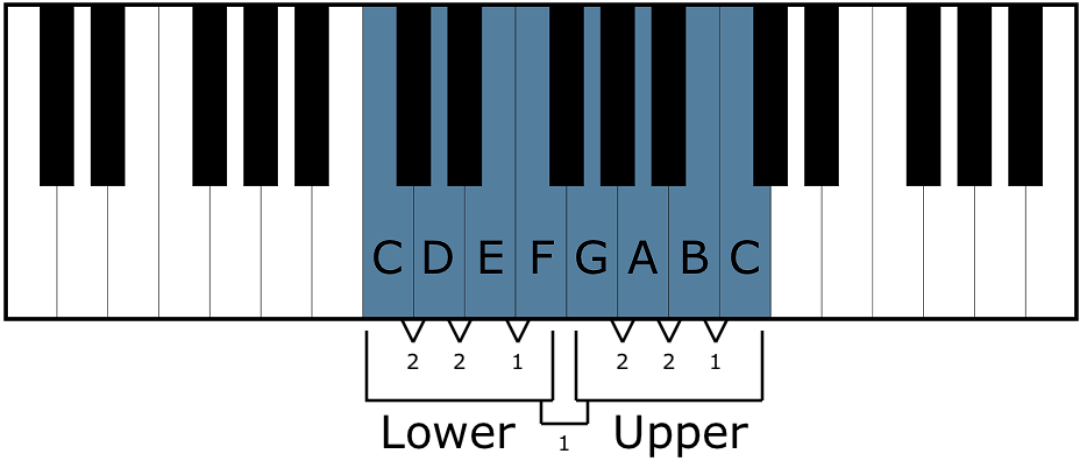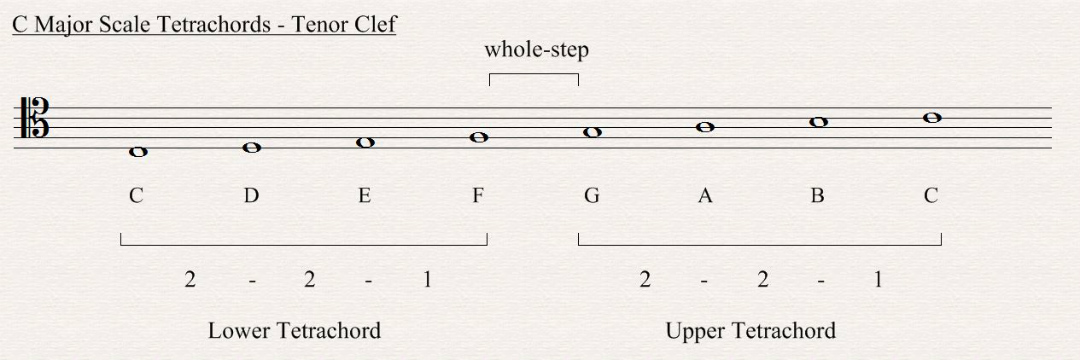C Major Scale

The C major scale consists of the following notes:
C D E F G A B
There are 7 different notes in the scale. When the scale is played, the first note is usually repeated at the end, one octave higher. In this case, that’s the note C. This kind of “rounds off” the scale, and makes it sound complete. (If it ended on B, it would sound like the scale is hanging in mid-air!) Therefore, sometimes the final C will be included in examples and diagrams, depending on the situation.
Here’s what it sounds like:
Scale Position
Each note has its very own position within the scale. For example, F is the 4th note, or degree, of the scale. The chart below shows the position of each note within the scale:

Sharps and Flats
The C major scale contains no sharps or flats. In other words, none of its notes have any accidentals, such as Ab’s or F#’s. All of the notes are natural.
Each major scale has a unique number of sharps or flats. This is indicated at the beginning of a piece of music, right after the clef, by a musical symbol called a key signature (and usually repeated on each new line of music after that). The C major scale is the only major scale with zero sharps or flats; therefore, no key signature is necessary at all. This lack of a key signature is one of the easiest ways to identify music in the key of C major.
C Major Scale on the Piano
The C major scale is the easiest major scale to visualize on the piano keyboard, because it is made up of only white keys. Here’s how it looks, spanning one octave (shown with note names):

Here it is with scale degree numbers:

Notice the unique major scale pattern: Whole, whole, half; whole, whole, whole, half.
All scales are infinite – they go on forever in both directions. The diagrams above show the scale over one octave, but keep in mind that this same pattern repeats itself across the keyboard.
Put It In Writing
Okay, now we’re going to see how this looks in music notation. The following examples show C major in all four commonly used clefs – treble, bass, alto , and tenor:




Notice how none of the notes have any flats or sharps in front of them. That’s the reason C major doesn’t need a key signature, like we mentioned earlier.
The rest of the notation examples in this lesson are going to be shown in treble clef, but all the examples are provided in the other 3 clefs at the end of the lesson.
The example below shows the C scale with its note names and scale degrees labelled:

And here’s an example displaying the unique scale pattern once again, this time in written form:

Solfege Syllables
“Solfege” is a musical system that assigns specific syllables to each degree of a scale, so that we can sing the notes of the scale and learn the special sound of each one. It’s really a great way to train your ears to know what you’re hearing!
Here is a chart showing the solfege syllables for each note in the C major scale:

Here are the solfege syllables shown on piano:

And in music notation:

Tetrachords
All major scales can be split in half, into two major tetrachords (a 4-note segment with the pattern 2-2-1, or whole-step, whole-step, half-step). It’s much easier to remember 4-note patterns than 7 or 8-note patterns, so breaking it down into two parts can be very helpful.
The lower tetrachord of C major is made up of the notes C, D, E, F.
The upper tetrachord is made up of the notes G, A, B, C.
These two 4-note segments are joined by a whole-step in the middle.
It’s helpful to see this on a piano diagram:

Here it is displayed in written music:

Traditional Scale Degree Names
In traditional harmony, special names are given to each scale degree. A lot of harmony textbooks use these names, so they’re useful to know.
Here’s a chart of the scale degree names for the C major scale:

And in music notation:

Finally, here’s a chart showing scale degree numbers, solfege syllables, and traditional scale degree names, all in one. This should make the relationship between all these things clear:

Notation Examples in Bass Clef
As promised, here are all the written examples from this lesson in the other 3 clefs, starting with bass clef:





Notation Examples in Alto Clef
Here are all the notation examples for alto (for all you viola players out there):





Notation Examples in Tenor Clef
One last set of examples, for tenor clef:





Practice Quiz
C Major Scale Quiz
Test your knowledge of this lesson with the following quiz:
Image Attribution:
practice makes perfect. by Jukie Bot ©2013 CC by 2.0